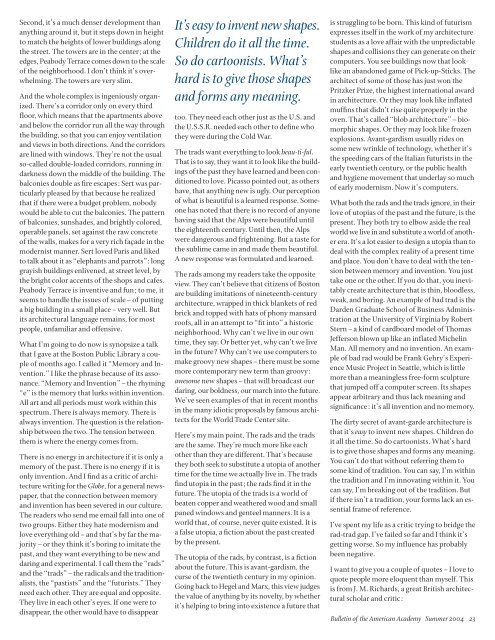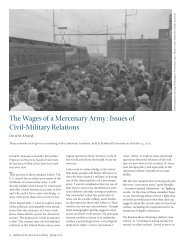Why Don't the Rest of Us Like the Buildings the Architects Like?
Why Don't the Rest of Us Like the Buildings the Architects Like?
Why Don't the Rest of Us Like the Buildings the Architects Like?
You also want an ePaper? Increase the reach of your titles
YUMPU automatically turns print PDFs into web optimized ePapers that Google loves.
Second, it’s a much denser development than<br />
anything around it, but it steps down in height<br />
to match <strong>the</strong> heights <strong>of</strong> lower buildings along<br />
<strong>the</strong> street. The towers are in <strong>the</strong> center; at <strong>the</strong><br />
edges, Peabody Terrace comes down to <strong>the</strong> scale<br />
<strong>of</strong> <strong>the</strong> neighborhood. I don’t think it’s overwhelming.<br />
The towers are very slim.<br />
And <strong>the</strong> whole complex is ingeniously organized.<br />
There’s a corridor only on every third<br />
floor, which means that <strong>the</strong> apartments above<br />
and below <strong>the</strong> corridor run all <strong>the</strong> way through<br />
<strong>the</strong> building, so that you can enjoy ventilation<br />
and views in both directions. And <strong>the</strong> corridors<br />
are lined with windows. They’re not <strong>the</strong> usual<br />
so-called double-loaded corridors, running in<br />
darkness down <strong>the</strong> middle <strong>of</strong> <strong>the</strong> building. The<br />
balconies double as ½re escapes: Sert was particularly<br />
pleased by that because he realized<br />
that if <strong>the</strong>re were a budget problem, nobody<br />
would be able to cut <strong>the</strong> balconies. The pattern<br />
<strong>of</strong> balconies, sunshades, and brightly colored,<br />
operable panels, set against <strong>the</strong> raw concrete<br />
<strong>of</strong> <strong>the</strong> walls, makes for a very rich façade in <strong>the</strong><br />
modernist manner. Sert loved Paris and liked<br />
to talk about it as “elephants and parrots”: long<br />
grayish buildings enlivened, at street level, by<br />
<strong>the</strong> bright color accents <strong>of</strong> <strong>the</strong> shops and cafes.<br />
Peabody Terrace is inventive and fun; to me, it<br />
seems to handle <strong>the</strong> issues <strong>of</strong> scale–<strong>of</strong> putting<br />
a big building in a small place–very well. But<br />
its architectural language remains, for most<br />
people, unfamiliar and <strong>of</strong>fensive.<br />
What I’m going to do now is synopsize a talk<br />
that I gave at <strong>the</strong> Boston Public Library a couple<br />
<strong>of</strong> months ago. I called it “Memory and Invention.”<br />
I like <strong>the</strong> phrase because <strong>of</strong> its assonance.<br />
“Memory and Invention”–<strong>the</strong> rhyming<br />
“e” is <strong>the</strong> memory that lurks within invention.<br />
All art and all periods must work within this<br />
spectrum. There is always memory. There is<br />
always invention. The question is <strong>the</strong> relationship<br />
between <strong>the</strong> two. The tension between<br />
<strong>the</strong>m is where <strong>the</strong> energy comes from.<br />
There is no energy in architecture if it is only a<br />
memory <strong>of</strong> <strong>the</strong> past. There is no energy if it is<br />
only invention. And I ½nd as a critic <strong>of</strong> architecture<br />
writing for <strong>the</strong> Globe, for a general newspaper,<br />
that <strong>the</strong> connection between memory<br />
and invention has been severed in our culture.<br />
The readers who send me email fall into one <strong>of</strong><br />
two groups. Ei<strong>the</strong>r <strong>the</strong>y hate modernism and<br />
love everything old–and that’s by far <strong>the</strong> majority–or<br />
<strong>the</strong>y think it’s boring to imitate <strong>the</strong><br />
past, and <strong>the</strong>y want everything to be new and<br />
daring and experimental. I call <strong>the</strong>m <strong>the</strong> “rads”<br />
and <strong>the</strong> “trads”–<strong>the</strong> radicals and <strong>the</strong> traditionalists,<br />
<strong>the</strong> “pastists” and <strong>the</strong> “futurists.” They<br />
need each o<strong>the</strong>r. They are equal and opposite.<br />
They live in each o<strong>the</strong>r’s eyes. If one were to<br />
disappear, <strong>the</strong> o<strong>the</strong>r would have to disappear<br />
It’s easy to invent new shapes.<br />
Children do it all <strong>the</strong> time.<br />
So do cartoonists. What’s<br />
hard is to give those shapes<br />
and forms any meaning.<br />
too. They need each o<strong>the</strong>r just as <strong>the</strong> U.S. and<br />
<strong>the</strong> U.S.S.R. needed each o<strong>the</strong>r to de½ne who<br />
<strong>the</strong>y were during <strong>the</strong> Cold War.<br />
The trads want everything to look beau-ti-ful.<br />
That is to say, <strong>the</strong>y want it to look like <strong>the</strong> buildings<br />
<strong>of</strong> <strong>the</strong> past <strong>the</strong>y have learned and been conditioned<br />
to love. Picasso pointed out, as o<strong>the</strong>rs<br />
have, that anything new is ugly. Our perception<br />
<strong>of</strong> what is beautiful is a learned response. Someone<br />
has noted that <strong>the</strong>re is no record <strong>of</strong> anyone<br />
having said that <strong>the</strong> Alps were beautiful until<br />
<strong>the</strong> eighteenth century. Until <strong>the</strong>n, <strong>the</strong> Alps<br />
were dangerous and frightening. But a taste for<br />
<strong>the</strong> sublime came in and made <strong>the</strong>m beautiful.<br />
A new response was formulated and learned.<br />
The rads among my readers take <strong>the</strong> opposite<br />
view. They can’t believe that citizens <strong>of</strong> Boston<br />
are building imitations <strong>of</strong> nineteenth-century<br />
architecture, wrapped in thick blankets <strong>of</strong> red<br />
brick and topped with hats <strong>of</strong> phony mansard<br />
ro<strong>of</strong>s, all in an attempt to “½t into” a historic<br />
neighborhood. <strong>Why</strong> can’t we live in our own<br />
time, <strong>the</strong>y say. Or better yet, why can’t we live<br />
in <strong>the</strong> future? <strong>Why</strong> can’t we use computers to<br />
make groovy new shapes–<strong>the</strong>re must be some<br />
more contemporary new term than groovy:<br />
awesome new shapes–that will broadcast our<br />
daring, our boldness, our march into <strong>the</strong> future.<br />
We’ve seen examples <strong>of</strong> that in recent months<br />
in <strong>the</strong> many idiotic proposals by famous architects<br />
for <strong>the</strong> World Trade Center site.<br />
Here’s my main point. The rads and <strong>the</strong> trads<br />
are <strong>the</strong> same. They’re much more like each<br />
o<strong>the</strong>r than <strong>the</strong>y are different. That’s because<br />
<strong>the</strong>y both seek to substitute a utopia <strong>of</strong> ano<strong>the</strong>r<br />
time for <strong>the</strong> time we actually live in. The trads<br />
½nd utopia in <strong>the</strong> past; <strong>the</strong> rads ½nd it in <strong>the</strong><br />
future. The utopia <strong>of</strong> <strong>the</strong> trads is a world <strong>of</strong><br />
beaten copper and wea<strong>the</strong>red wood and small<br />
paned windows and genteel manners. It is a<br />
world that, <strong>of</strong> course, never quite existed. It is<br />
a false utopia, a ½ction about <strong>the</strong> past created<br />
by <strong>the</strong> present.<br />
The utopia <strong>of</strong> <strong>the</strong> rads, by contrast, is a ½ction<br />
about <strong>the</strong> future. This is avant-gardism, <strong>the</strong><br />
curse <strong>of</strong> <strong>the</strong> twentieth century in my opinion.<br />
Going back to Hegel and Marx, this view judges<br />
<strong>the</strong> value <strong>of</strong> anything by its novelty, by whe<strong>the</strong>r<br />
it’s helping to bring into existence a future that<br />
is struggling to be born. This kind <strong>of</strong> futurism<br />
expresses itself in <strong>the</strong> work <strong>of</strong> my architecture<br />
students as a love affair with <strong>the</strong> unpredictable<br />
shapes and collisions <strong>the</strong>y can generate on <strong>the</strong>ir<br />
computers. You see buildings now that look<br />
like an abandoned game <strong>of</strong> Pick-up-Sticks. The<br />
architect <strong>of</strong> some <strong>of</strong> those has just won <strong>the</strong><br />
Pritzker Prize, <strong>the</strong> highest international award<br />
in architecture. Or <strong>the</strong>y may look like inflated<br />
muf½ns that didn’t rise quite properly in <strong>the</strong><br />
oven. That’s called “blob architecture”–biomorphic<br />
shapes. Or <strong>the</strong>y may look like frozen<br />
explosions. Avant-gardism usually rides on<br />
some new wrinkle <strong>of</strong> technology, whe<strong>the</strong>r it’s<br />
<strong>the</strong> speeding cars <strong>of</strong> <strong>the</strong> Italian futurists in <strong>the</strong><br />
early twentieth century, or <strong>the</strong> public health<br />
and hygiene movement that underlay so much<br />
<strong>of</strong> early modernism. Now it’s computers.<br />
What both <strong>the</strong> rads and <strong>the</strong> trads ignore, in <strong>the</strong>ir<br />
love <strong>of</strong> utopias <strong>of</strong> <strong>the</strong> past and <strong>the</strong> future, is <strong>the</strong><br />
present. They both try to elbow aside <strong>the</strong> real<br />
world we live in and substitute a world <strong>of</strong> ano<strong>the</strong>r<br />
era. It’s a lot easier to design a utopia than to<br />
deal with <strong>the</strong> complex reality <strong>of</strong> a present time<br />
and place. You don’t have to deal with <strong>the</strong> tension<br />
between memory and invention. You just<br />
take one or <strong>the</strong> o<strong>the</strong>r. If you do that, you inevitably<br />
create architecture that is thin, bloodless,<br />
weak, and boring. An example <strong>of</strong> bad trad is <strong>the</strong><br />
Darden Graduate School <strong>of</strong> Business Administration<br />
at <strong>the</strong> University <strong>of</strong> Virginia by Robert<br />
Stern–a kind <strong>of</strong> cardboard model <strong>of</strong> Thomas<br />
Jefferson blown up like an inflated Michelin<br />
Man. All memory and no invention. An example<br />
<strong>of</strong> bad rad would be Frank Gehry’s Experience<br />
Music Project in Seattle, which is little<br />
more than a meaningless free-form sculpture<br />
that jumped <strong>of</strong>f a computer screen. Its shapes<br />
appear arbitrary and thus lack meaning and<br />
signi½cance: it’s all invention and no memory.<br />
The dirty secret <strong>of</strong> avant-garde architecture is<br />
that it’s easy to invent new shapes. Children do<br />
it all <strong>the</strong> time. So do cartoonists. What’s hard<br />
is to give those shapes and forms any meaning.<br />
You can’t do that without referring <strong>the</strong>m to<br />
some kind <strong>of</strong> tradition. You can say, I’m within<br />
<strong>the</strong> tradition and I’m innovating within it. You<br />
can say, I’m breaking out <strong>of</strong> <strong>the</strong> tradition. But<br />
if <strong>the</strong>re isn’t a tradition, your forms lack an essential<br />
frame <strong>of</strong> reference.<br />
I’ve spent my life as a critic trying to bridge <strong>the</strong><br />
rad-trad gap. I’ve failed so far and I think it’s<br />
getting worse. So my influence has probably<br />
been negative.<br />
I want to give you a couple <strong>of</strong> quotes–I love to<br />
quote people more eloquent than myself. This<br />
is from J. M. Richards, a great British architectural<br />
scholar and critic:<br />
Bulletin <strong>of</strong> <strong>the</strong> American Academy Summer 2004 23




